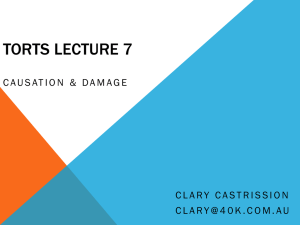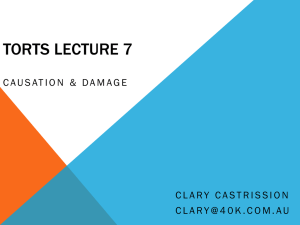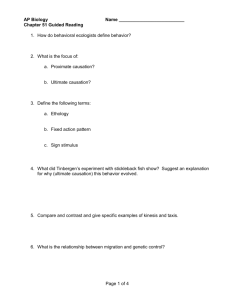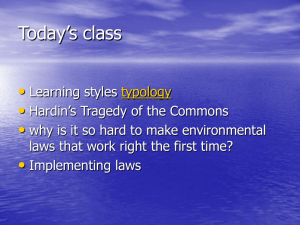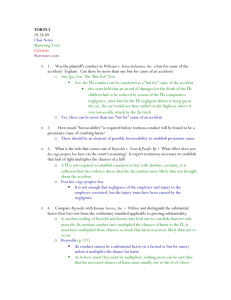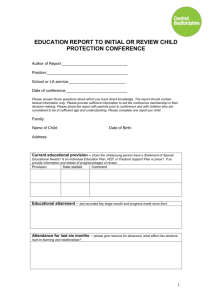TORTS LECTURE 7
advertisement
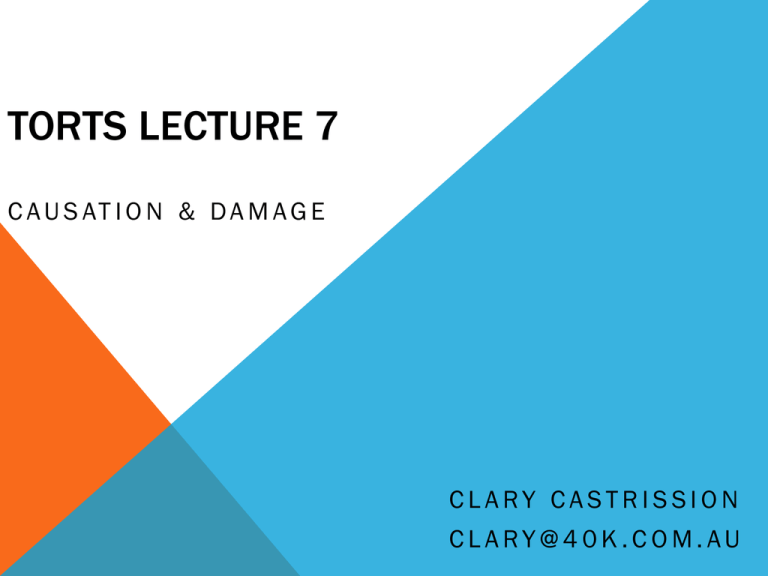
TORTS LECTURE 7 C A U S AT I O N & D A M A G E CLARY CASTRISSION CLARY@40K.COM.AU NEW HIGH COURT CASE IN 2012 Woolworths Limited v Strong & Anor [2010] NSWCA 282 (2 November 2010) http://www.austlii.edu.au/cgibin/sinodisp/au/cases/nsw/NSWCA/2010/282.html?stem=0&synonyms=0&qu ery=title(strong%20and%20woolworths%20) Strong v Woolworths Ltd [2012] HCA 5 (7 March 2012) http://www.austlii.edu.au/cgibin/sinodisp/au/cases/cth/HCA/2012/5.html?stem=0&synonyms=0&query=titl e(strong%20and%20woolworths%20) See SMH article http://www.smh.com.au/nsw/high-court-backs-amputees-580000-chipslip-payout20120307-1ukkn.html Tonight’s lecture 1. Understanding ‘damage’ in negligence claims 2. Factual Causation 1.The But For test 2.Limitations of the But For Test 3.Interesting situations 4.Novus Actus Interveniens 3. Legal Causation (remoteness) 1.Egg-Shell Skull Cases 4. s5D of the CLA 5. Bringing Negligence together… DAMAGE IN NEGLIGENCE Duty of care Negligence Breach Damage DAMAGE IN NEGLIGENCE Damage is the gist of the action in Negligence The scope of actionable damage (s5 CLA): property personal Mental: s31 pure economic loss Damage must be actual for compensation; no cause of action accrues until damage 2 STEP PROCESS 1. Factual causation 2. Legal causation (remoteness) 1. FACTUAL CAUSATION For P to be successful in an action in Negligence, D’s breach of duty must cause damage to P or his/her property Fitzgerald v Penn (1954) 91 CLR 268 at 277-8: It is a mistake to attempt either to explain ‘causation’ as a general conception to a jury or to define for them a degree of closeness which must subsist in the connection between wrongdoing and damage. To begin with, it is not really necessary, because a jury is expected to have a sound common sense idea of what is meant by saying that one fact is a cause of another, and it is all ultimately a matter of common sense. March v Stramare Chappel v Hart 1. Factual causation (cont) The ‘but for’ test Would the P still have suffered the harm but for D’s negligence? • Barnett v Chelsea and Kensington Hospital [1969] 1 QB 428 1. Factual causation (cont) Limitations on the ‘but for’ test 1. Trouble with eliminating ‘contributing reasons’ 2. Two or more tortious acts March v Stramare (1991) 171 CLR 506 per Deane J (at 523): [The ‘But For’ test should not be the exclusive test as it] “would lead to the absurd and unjust position that there was no ‘cause’ of an injury in any case where there were present two independent and sufficient causes of the accident in which the injury was sustained.” (at 523) What happens when you can’t conclusively prove the defendant caused the harm? McGhee v National Coal Board (1973) 1 WLR 1 And in Australia… Chappel v Hart (1998) 1995 CLR 232 McHugh J at [27]: If a wrongful act or omission results in an increased risk of injury… and that risk eventuates, the defendant’s conduct has materially contributed to the injury… whether or not other factors have also contributed. NOVUS ACTUS INTERVENIENS D will avoid liability if the subsequent act that exacerbated/caused the injury was not reasonably foreseeable: March v Stramare. Lord Wright in The Oropesa [1943] P 32 “To break the chain of causation it must be shown that there is something I will call ultroneous, something unwarrantable, a new cause which disturbs the sequence of events, something which can be described as either unreasonable or extraneous or extrinsic” Haber v Walker [1963] VR 339 Very hard to prove: Chapman v Hearse Kavanagh v Akhtar (1998) 45 NSWLR 588 Where it has worked McKew v Holland & Hannon & Cubitts Ltd [1969] 3 All ER 1621 2. LEGAL CAUSATION (REMOTENESS) Whether the scope of negligence should extend to the harm caused. Beavis v Apthorpe (1962) 80 WN (NSW) 852 at 856 per Herron CJ: In one sense, almost nothing is quite unforeseeable, since there is a very slight mathematical chance, recognizable in advance, that even the most freakish accidents will occur. In another, nothing is entirely foreseeable, since the exact details of a sequence of events never can be predicted with complete confidence. REMOTENESS Were the injuries a reasonably foreseeable consequence of the act? Wagonmound No. 1 [1961] AC 388 Wagonmound No. 2 [1967] AC 617 Chapman v Hearse Type of harm being foreseeable Tremain v Pike [1969] 3 All ER 1303 Bradford v Robinson Rentals Ltd [1967] 1 All ER 267 Hughes v Lord Advocate [1963] AC 837 EGG-SHELL SKULL CASES Negretto v Sayers [1963] SASR 313 at 318. Nader v Urban Transit Authority of NSW (1985) 2 NSWLR 501 Golder v Caledonian Railway Co (1902) 5 F (Ct of Sess) 123 S5D CLA (1) A determination that negligence caused particular harm comprises the following elements: (a) that the negligence was a necessary condition of the occurrence of the harm ( "factual causation"), and (b) that it is appropriate for the scope of the negligent person’s liability to extend to the harm so caused ( "scope of liability"). (2) In determining in an exceptional case, in accordance with established principles, whether negligence that cannot be established as a necessary condition of the occurrence of harm should be accepted as establishing factual causation, the court is to consider (amongst other relevant things) whether or not and why responsibility for the harm should be imposed on the negligent party. (3) If it is relevant to the determination of factual causation to determine what the person who suffered harm would have done if the negligent person had not been negligent: (a) the matter is to be determined subjectively in the light of all relevant circumstances, subject to paragraph (b), and (b) any statement made by the person after suffering the harm about what he or she would have done is inadmissible except to the extent (if any) that the statement is against his or her interest. (4) For the purpose of determining the scope of liability, the court is to consider (amongst other relevant things) whether or not and why responsibility for the harm should be imposed on the negligent party. STRONG V WOOLWORTHS [2012] HCA 5 Facts Issue at High Court Held “A necessary condition is a condition that must be present for the occurrence of the harm. However, there may be more than one set of conditions necessary for the occurrence of particular harm and it follows that a defendant’s negligent act or omission which is necessary to complete a set of conditions that are jointly sufficient to account for the occurrence of the harm will meet the test of factual causation within s5D(1)(a).: (per French CJ, Gummow, Crennan and Bell JJ at 20) Tonight’s lecture 1. Understanding ‘damage’ in negligence claims 2. Factual Causation 1.The But For test 2.Limitations of the But For Test 3.Interesting situations 4.Novus Actus Interveniens 3. Legal Causation (remoteness) 1.Egg-Shell Skull Cases 4. s5D of the CLA 5. Bringing Negligence together… BRINGING IT ALL TOGETHER- YOUR TURN Paul owned a restaurant in Liverpool (Sydney) called “The Cavern Club,” which was licensed to serve alcohol between midday and 4am each day. The restaurant, on the 2nd floor of a building, had never had any violent incidents before, apart from one occasion three years ago when a bikie gang called “The Stones” yelled abuse at some patrons. On Australia Day Eve last year, The Cavern Club was open for a dinner and dance- 295 people booked in advance to attend. It was attended largely by groups of families, including children and the elderly. Alcohol was served to patrons. Paul figured that because there had never been any issues in his restaurant, there was no need to hire any security guards for the evening. A fight broke out between two women, Linda and Yoko on the dancefloor. Chairs, plates and bottles thrown. Onlookers joined in and before you knew it, it was an all-out brawl. One man, John, was hit in the face by Ringo, drawing blood. John left and came back with a gun. When another man, George, saw John come into the restaurant with a gun, he ran into the kitchen and slipped. John followed him into the kitchen, and despite George begging and pleading to not be shot, he was shot in the leg. John then went and found Ringo, who drew the first blood, and shot him in the stomach. Advise George and Ringo (together) as to whether they can sue The Cavern Club. Do not discuss damages. BRINGING IT ALL TOGETHER Adeels Palace Pty Ltd v Moubarak; Adeels Palace Pty Ltd v Bou Najem [2009] HCA 48 (10 November 2009) Unanimous Decision by French CJ, Gummow, Hayne, Heydon and Crennan JJ • DUTY OF CARE: Whether D owed DOC to prevent injury from conduct of other patrons • BREACH: Whether licensed security personnel ought to have been provided • CAUSATION: Whether absence of licensed security personnel was a necessary condition for the shootings to take place DUTY OF CARE • Liquor Act 1982 s125 (now repealed in favour of Liquor Act 2007- s 73) • licensee must not permit any indecent, violent or quarrelsome conduct. Licensee permitted to ‘turn out’ people engaged in this. BREACH OF DUTY • s5B 1) A person is not negligent in failing to take precautions against a risk of harm unless: (a) the risk was foreseeable (that is, it is a risk of which the person knew or ought to have known), and (b) the risk was not insignificant, and (c) in the circumstances, a reasonable person in the person’s position would have taken those precautions. (2) In determining whether a reasonable person would have taken precautions against a risk of harm, the court is to consider the following (amongst other relevant things): (a) the probability that the harm would occur if care were not taken, (b) the likely seriousness of the harm, (c) the burden of taking precautions to avoid the risk of harm, (d) the social utility of the activity that creates the risk of harm. CAUSATION (1) A determination that negligence caused particular harm comprises the following elements: (a) that the negligence was a necessary condition of the occurrence of the harm ( "factual causation"), and (b) that it is appropriate for the scope of the negligent person’s liability to extend to the harm so caused ( "scope of liability"). (2) In determining in an exceptional case, in accordance with established principles, whether negligence that cannot be established as a necessary condition of the occurrence of harm should be accepted as establishing factual causation, the court is to consider (amongst other relevant things) whether or not and why responsibility for the harm should be imposed on the negligent party. (3) If it is relevant to the determination of factual causation to determine what the person who suffered harm would have done if the negligent person had not been negligent: (a) the matter is to be determined subjectively in the light of all relevant circumstances, subject to paragraph (b), and (b) any statement made by the person after suffering the harm about what he or she would have done is inadmissible except to the extent (if any) that the statement is against his or her interest. (4) For the purpose of determining the scope of liability, the court is to consider (amongst other relevant things) whether or not and why responsibility for the harm should be imposed on the negligent party. CAUSATION CONTINUED… “It must also be recognised that before theCivil Liability Act and equivalent provisions were enacted, it had been recognised[37] that the "but for" test was not always a sufficient test of causation. But as s 5D(1) shows, the "but for" test is now to be (and has hitherto been seen to be) a necessary test of causation in all but the undefined group of exceptional cases contemplated by s 5D(2).” [55]
